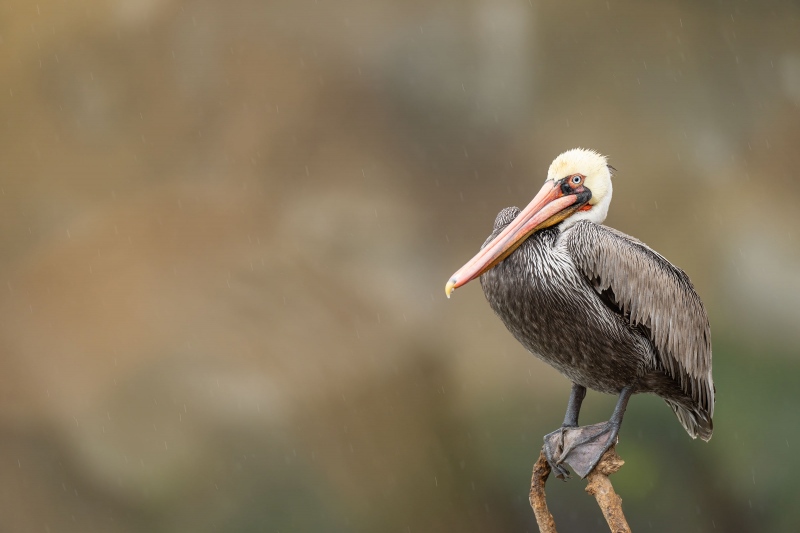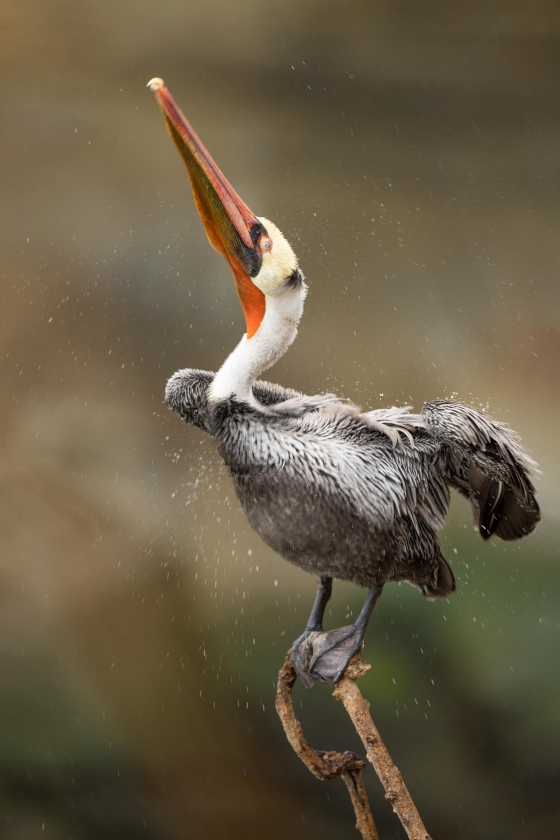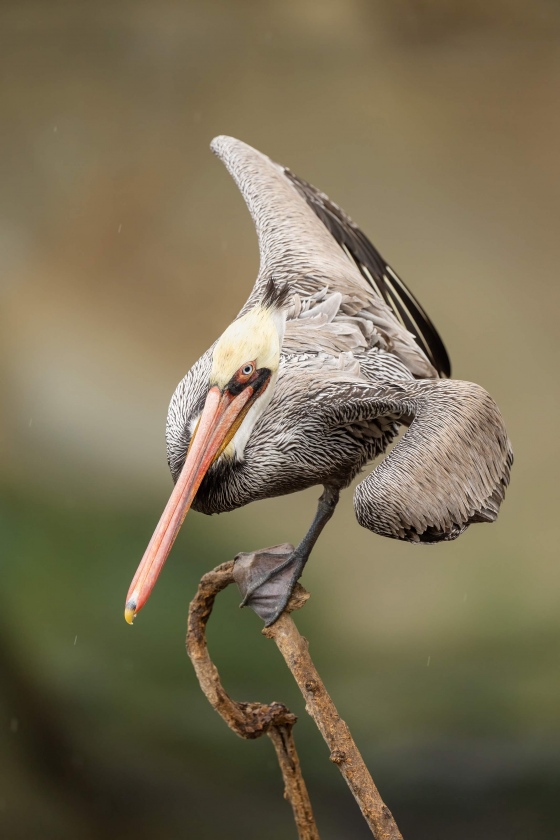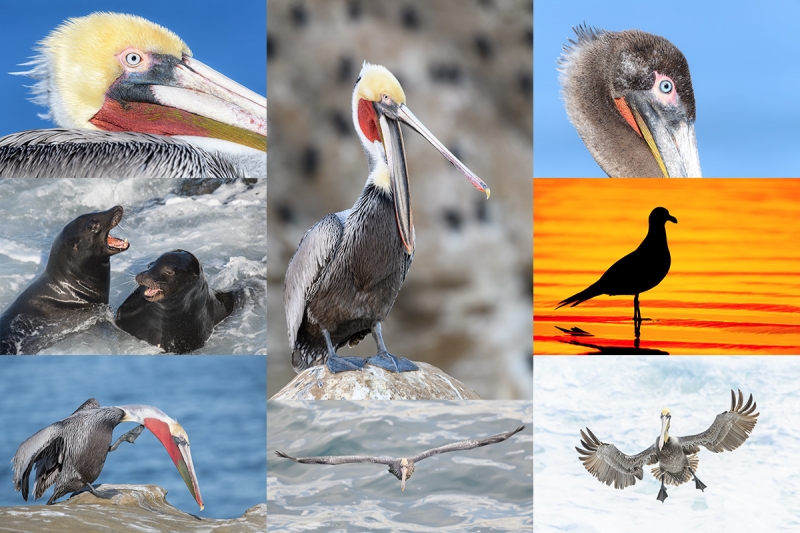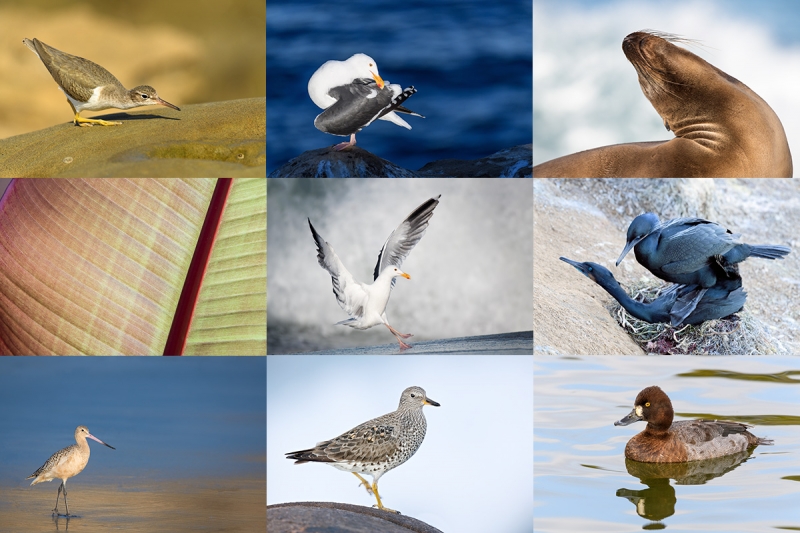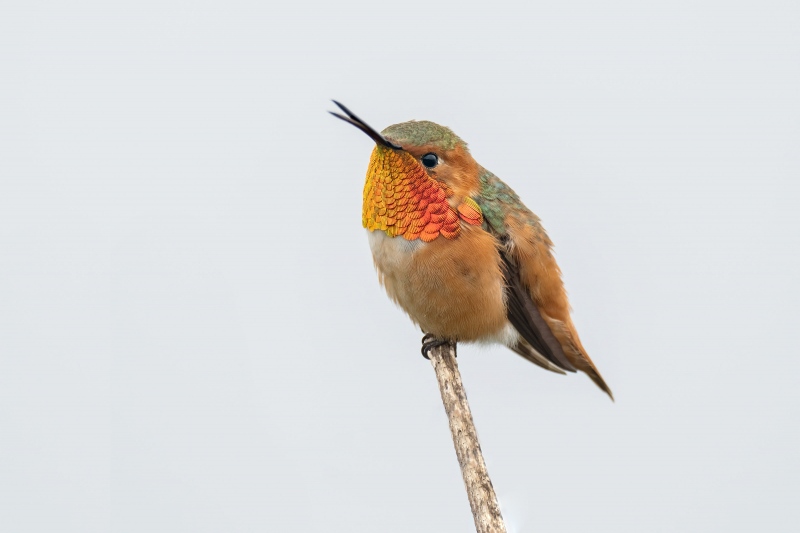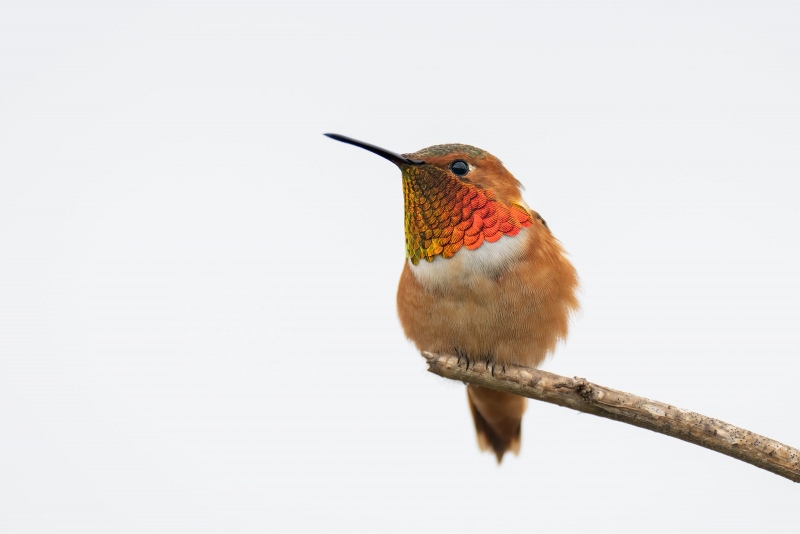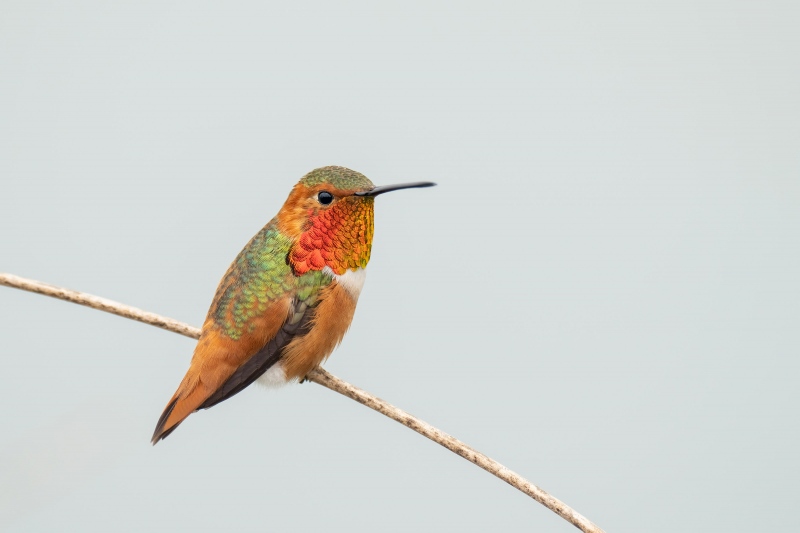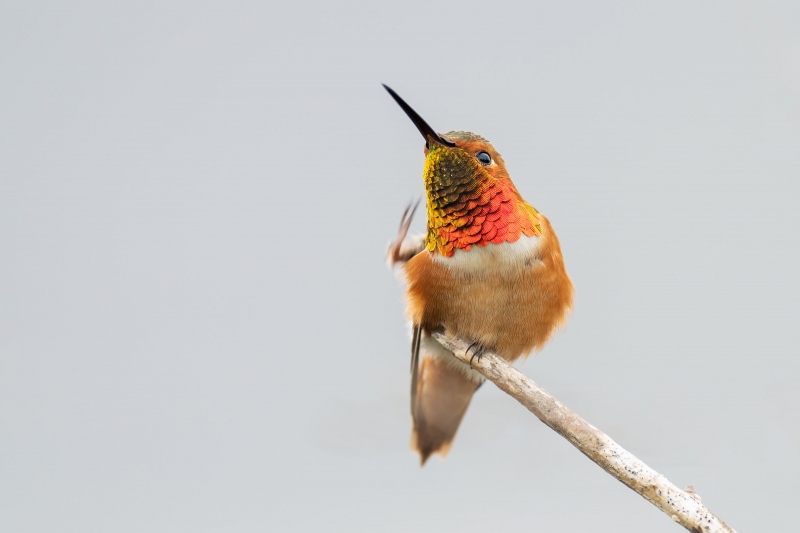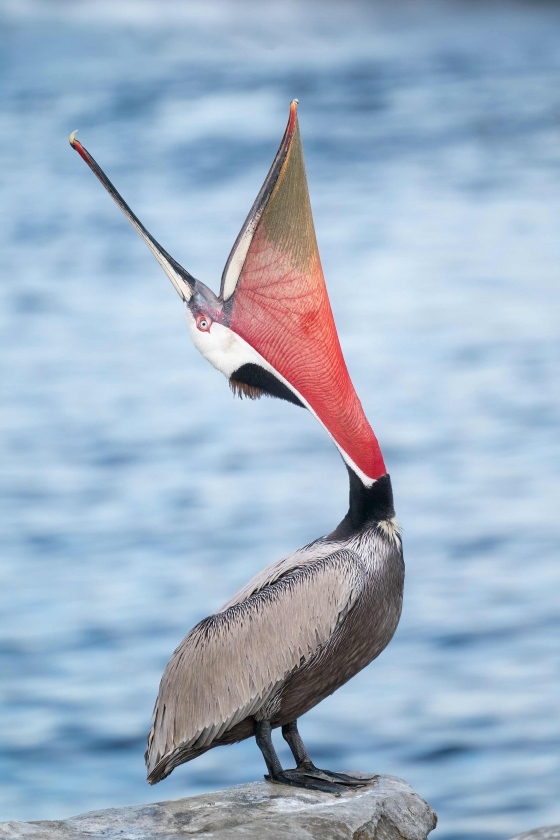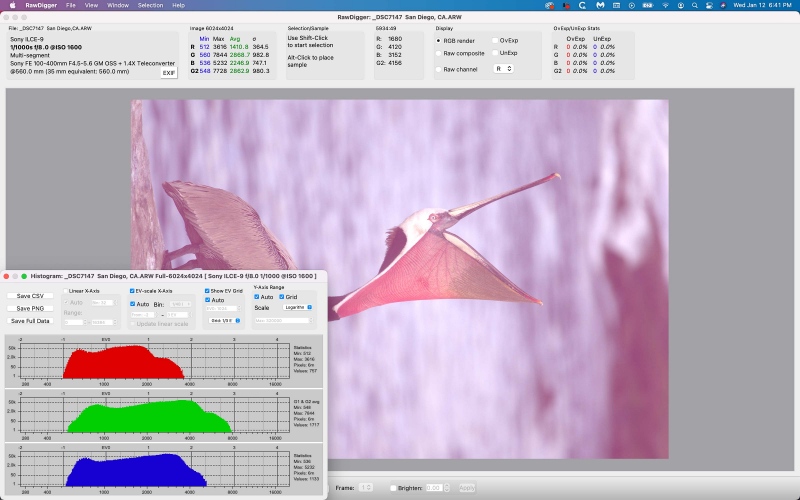January 17th, 2022 Your Fave?
Thanks to all who commented on the Allen’s Hummingbird images. I am still excited about those. All are invited to leave a comment letting us know which of today’s three pelican images is their favorite, and why they made their choice.
What’s Up?
Carolyn Johnson, a shipmate on a Southern Ocean voyage about ten years ago, called me about two months ago wanting to sign up for the first San Diego IPT. I asked her about her gear — she was using Nikon at the time. We talked for a bit and I shared my experiences with Sony, especially with the a1 and the 200-600 G lens. I thought that that combo would be perfect for her. Wanting very much to improve her photography, she followed my advice and purchased both items from Bedfords (thank her very much). When we met early on Sunday morning, she had never used the camera. Now the word on the street is that the a1 is a difficult camera to use with a menu that is nearly impossible to understand. That may very well be true if you do not know how set up the camera. We had loaded my CAMSETA2.DAT onto Carolyn’s camera body. I sat with her for ten minutes demonstrating how to set the right exposure using (properly set-up) Zebras, and how to use the AF system. She was astonished as she watched the back of my camera as it tracked the eye seamlessly in with both Tracking: Spot S and Tracking: Zone. And when she tried it herself she was even more astonished.
She worked off the tripod for a bit, but when the light levels increased, she began hand holding her rig and did so with ease. Carolyn is on the petite side and is 78 years young. Not to mention that she learned to use her new camera in ten minutes flat.
She sent me a text that afternoon, and I quote:
Artie, I am sitting here in tears as the photos are so good. Thank you, thank you, thank you.
The fact is that set up correctly, the a1 is super-easy to learn to use. You can begin making excellent photographs in short order.
Today is Monday 17 January. The forecast for this morning is for mostly to mostly cloudy skies with a gentle breeze from the southeast. Carolyn’s daughter Marni was delayed a day and will be joining us early today. Wherever you are, and whatever you are doing, I hope that you too have a great day. This blog post took more than two hours to prepare and makes 67 consecutive days with a new one.
Please remember that you can find some great photo accessories (and necessities, like surf booties!) on Amazon by clicking on the Stuff tab on the orange/yellow menu bar above. On a related note, it would be extremely helpful if blog-folks who, like me, spend too much money on Amazon, would get in the habit of clicking on the Amazon logo link on the right side of each blog post when they shop online. As you might expect, doing so will not cost you a single penny, but would be appreciated tremendously by yours truly. And doing so works seamlessly with your Amazon Prime account.
Please remember that if an item — a Delkin flash card, or a tripod head — for example, that is available from B&H and/or Bedfords, is also available in the BAA Online Store, it would be great, and greatly appreciated, if you would opt to purchase from us. We will match any price. Please remember also to use my B&H affiliate links or to save 3% at Bedfords by using the BIRDSASART discount code at checkout for your major gear purchases. Doing either often earns you free guides and/or discounts. And always earns my great appreciation.
|
|
|
This image was created on 15 January 2022, my first morning in La Jolla. Standing at full height on the sidewalk, I used the no-longer-available Induro GIT 304L/Levered-Clamp FlexShooter Pro-mounted Sony FE 600mm f/4 GM OSS lens and The One, the Sony Alpha 1 Mirrorless Digital Camera). IS 640. The exposure was determined via Zebras with ISO on the rear wheel: 1/320 sec. at f/4 (wide open) in Manual mode. AWB at 8:44:26am on a mostly sunny morning.
Tracking: Spot S AF-C performed very well. Be sure to click on the image to enjoy a higher-res version.
Image #1: Brown Pelican on curved branch perch
|
The Discovery
I was working for two hours with the amazing Sony FE 70-200mm f/2.8 GM OSS II lens when I saw this bird on the crazy-beautiful perch. There was a small opening through the bushes and it looked as if I could get a long lens on the bird. So I headed back to the car and grabbed the 600 and the tripod. I was thrilled when I returned and found the bird still sitting on the same perch. Image #1 is a straight-forward horizontal portrait of the whole bird. I found the distant cliff-wall background to be quite lovely.
I almost forgot to mention that at times on Sunday morning it was drizzling pretty good.
|
|
|
This image was created on 15 January 2022, my first morning in La Jolla. Standing at full height on the sidewalk, I used the no-longer-available Induro GIT 304L/Levered-Clamp FlexShooter Pro-mounted Sony FE 600mm f/4 GM OSS lens and The One, the Sony Alpha 1 Mirrorless Digital Camera). IS 640. The exposure was determined via Zebras with ISO on the rear wheel: 1/320 sec. at f/4 (wide open) in Manual mode. AWB at 8:45:17am on a mostly sunny morning.
Tracking: Spot S AF-C performed very well. Be sure to click on the image to enjoy a higher-res version.
Image #2: Brown Pelican shaking off rain
|
Missing the Head Throw!
Working horizontally, when the bird did a perfect head throw I was dead in the water; I did not even press the shutter button. So I switched to vertical, but alas, that was the last head throw. The bird did, however, raise its head while shaking off the rain. Score one for vertical. Would you have replaced the eye in this frame? Why or why not?
|
|
|
This image was created on 15 January 2022, my first morning in La Jolla. Standing at full height on the sidewalk, I used the no-longer-available Induro GIT 304L/Levered-Clamp FlexShooter Pro-mounted Sony FE 600mm f/4 GM OSS lens and The One, the Sony Alpha 1 Mirrorless Digital Camera). IS 1000. The exposure was determined via Zebras with ISO on the rear wheel: 1/500 sec. at f/4 (wide open) in Manual mode. AWB at 8:44:26am on a mostly sunny morning.
Tracking: Spot S AF-C performed very well. Be sure to click on the image to enjoy a higher-res version.
Image #3: Brown Pelican stretching
|
Score Two for Vertical
When the bird leaned forward to stretch its right wing, it fit perfectly into the still vertical frame. This image was cropped a bit on all sides but the bottom.
|
|
|
San Diego offers a wealth of very attractive natural history subjects, including and especially the Pacific race of California Brown Pelican. With annual visits spanning more than four decades, I have lots of photographic experience there … Click on the composite to enjoy a larger version.
|
The 2022 San Diego Brown Pelicans (and more!) Mini IPT. Monday 24 January thru the morning session on Wednesday 26 January 2022. Three mornings and two afternoons: $1649.00. Deposit: $499.00. Limit: 6 photographers
Join me in San Diego to photograph the spectacular breeding plumage Brown Pelicans with their fire-engine red and olive green bill pouches; Brandt’s (nesting with eggs and possibly chicks) and Double-crested Cormorants; breeding plumage Wood and Ring-necked Duck; other duck species possible including Lesser Scaup, Redhead, Northern Shoveler and Surf Scoter; a variety of gulls including Western, California, and the gorgeous Heermann’s, all in full breeding plumage; shorebirds including Marbled Godwit, Willet, Sanderling and Black-bellied Plover; many others are possible including Least, Western, and Spotted Sandpiper, Whimbrel, Black and Ruddy Turnstone, Semipalmated Plover, and Surfbird; Harbor Seals (depending on the current regulations) and California Sea Lions. And as you can see by studying the IPT cards, there are some nice bird-scape and landscape opportunities as well. Not to mention a ton of excellent flight photography opportunities and instruction.
Please note: where permitted and on occasion, ducks and gulls may be attracted (or re-located) with offerings of grains or healthy bread.
Learning Exposure, Whether You Like It Or Not
Whether you like it or not, we will be beating the subject of exposure like a dead horse. In every new situation, you will hear my thoughts on the exposure situation along with my thoughts on both Nikon and Canon histograms and SONY Zebras. Whether you like it or not, you will learn to work in manual mode and to get the right exposure every time as long as a bird gives you ten seconds with the light constant. (Or two seconds with SONY zebras…) And you will learn what to do when the light is changing constantly. What you learn about exposure is one of the great takeaways on every IPT.
|
|
|
Though the pelicans will be the stars of the show on this IPT, there will be many other handsome and captivating subjects in wonderful settings. Click on the composite to enjoy a larger version.
|
It Ain’t Just Pelicans
With gorgeous subjects just sitting there waiting to have their pictures taken, photographing the pelicans on the cliffs is about as easy as nature photography gets. With the winds from the east almost every morning there is usually some excellent flight photography as well, often with 70-200mm lenses! And the pelicans are almost always doing something interesting: preening, scratching, bill pouch cleaning, or squabbling. And then there are those crazy head throws that are thought to be a form of intra-flock communication. You will be guided as to how to make the best of all of those opportunities. And depending on the weather and local conditions and tides, there are a variety of other fabulous photo chances available in and around San Diego.
|

|
|
Did I mention that there are lots of great birds and natural history subjects in San Diego in winter? Click on the composite to enjoy a larger version.
|
The San Diego Details
This IPT will include five three hour morning photo sessions, four one and one-half afternoon photo sessions, four working brunches that will include image review and Photoshop sessions. On rare cloudy day occasions, we may — at my discretion, stay out in the morning for a long session and skip that afternoon. To ensure early starts, breakfasts will be your responsibility. And so that we can get some sleep, dinners will be on your own as well. In the extremely unlikely event that Goldfish Point is closed due to local ordinance (or whimsy) — that has never happened in the past fifty years, I will of course do my very best to maximize our photographic opportunities.
A $499 deposit is required to hold your slot for this IPT. Best would be to call Jim or Jennifer at the office with a credit card at 863-692-0906. Your balance, payable only by check, is due immediately.
|

|
|
Variety is surely the spice of life in San Diego. Click on the composite to enjoy a larger version.
|
Getting Up Early and Staying Out Late
On all BIRDS AS ART IPTS including and especially the San Diego IPT, we get into the field early to take advantage of unique and often spectacular lighting conditions and we stay out late to maximize the chances of killer light and glorious sunset silhouette situations. We often arrive at the cliffs a full hour before anyone else shows up to check out the landscape and seascape opportunities.
Typos
With all blog posts, feel free to e-mail or to leave a comment regarding any typos or errors.
January 16th, 2022 Thank You Nice Lady
On Saturday, I was photographing pelicans from the sidewalk and getting some really nice stuff on a lousy weather/great photography day in San Diego. A lady walked by and said, “There’s a male Allen’s Hummingbird up on the Coast Walk Trail.” “Thanks,” I said, “I have been photographing birds for 38 years and have never had any kind of chance on that species.” Thank you lady indeed.
What’s Up?
It was a drizzly morning in San Diego. There was little light at first. There were lots of pelicans and lots of tourists walking around on the cliffs scaring off first some and then all of the pelicans. I photographed hand held for two hours with the amazing Sony FE 70-200mm f/2.8 GM OSS II lens. You can learn more about why this lens is so much better than the original version and why it makes the Sony FE 100-400 GM lens obsolete in the blog post here. When the pelicans relocated, I did the same. Then I saw a nice pelican image in my mind and went back to the car to grab the 600 f/4 and the tripod. I was thrilled that the bird had not moved an inch when I got back to the spot.
Today is Sunday 16 January 2022. The forecast for this morning is for partly to mostly cloudy with a northeast breeze. Excellent. I am meeting long-ago shipmate Carolyn Johnson and her daughter Marni Nagy for a pre-IPT free morning. Carolyn is new to the Sony A1 and Marni is with my old friend, the Nikon D850. We are looking forward to a grand time. Wherever you are, and whatever you are doing, I hope that you too have a great day. This blog post took more than two hours to prepare and makes 67 consecutive days with a new one.
Please remember that you can find some great photo accessories (and necessities, like surf booties!) on Amazon by clicking on the Stuff tab on the orange/yellow menu bar above. On a related note, it would be extremely helpful if blog-folks who, like me, spend too much money on Amazon, would get in the habit of clicking on the Amazon logo link on the right side of each blog post when they shop online. As you might expect, doing so will not cost you a single penny, but would be appreciated tremendously by yours truly. And doing so works seamlessly with your Amazon Prime account.
Please remember that if an item — a Delkin flash card, or a tripod head — for example, that is available from B&H and/or Bedfords, is also available in the BAA Online Store, it would be great, and greatly appreciated, if you would opt to purchase from us. We will match any price. Please remember also to use my B&H affiliate links or to save 3% at Bedfords by using the BIRDSASART discount code at checkout for your major gear purchases. Doing either often earns you free guides and/or discounts. And always earns my great appreciation.
Sony Alpha 1 Bodies in Stock at Bedfords/free card offer!
Steve Elkins of Bedfords let me know recently that he had several Sony a1 bodies in stock. If one of them has your name on it, please click here and be sure to enter the BIRDSASART coupon code check the box for free shipping to enjoy free Second Day Air Fed-Ex. Right now, in lieu of the 3% credit refunded to the card you used for your purchase, you will receive a Sony 160GB CFexpress Type A TOUGH Memory Card, a $399.99 value!
Brand New and As-Good-As-Ever Bedfords BAA Discount Policy
Folks who have fallen in love with Bedfords can now use the BIRDSASART coupon code at checkout to enjoy a post-purchase, 3% off-statement credit (excluding taxes and shipping charges) on orders paid with a credit card. The 3% credit will be refunded to the card you used for your purchase. Be sure, also, to check the box for free shipping to enjoy free Second Day Air Fed-Ex. This offer does not apply to purchases of Classes, Gift Cards, or to any prior purchases.
Money Saving Reminder
Many have learned that if you need a hot photo item that is out of stock at B&H and would like to enjoy getting 3% back on your credit card along with free 2nd Day Air Fed-Ex Air shipping, your best bet is to click here, place an order with Bedfords, and enter the coupon code BIRDSASART at checkout. If an item is out of stock, contact Steve Elkins via e-mail or on his cell phone at (479) 381-2592 (Central time). Be sure to mention the BIRDSASART coupon code and check the box for Free Shipping. That will automatically upgrade to free 2nd Day Air Fed-Ex. Steve has been great at getting folks the hot items that are out of stock at B&H and everywhere else. The waitlists at the big stores can be a year or longer for the hard to get items. Steve will surely get you your gear long before that. For the past year, he has been helping BAA Blog folks get their hands on items like the SONY a 1, the SONY 200-600 G OSS lens, the Canon EOS R5, the Canon RF 100-500mm lens, and the Nikon 500mm PF. Steve is personable, helpful, and eager to please.
Important Note
As an Amazon Associate, I earn a small percentage when you purchase from Amazon after using any of the Amazon links on the blog (including the logo-link immediately above). My link works with Amazon Prime and using it will not cost you a single cent. Huge thanks, BTW 🙂
Please Remember Also
Please, if you enjoy and learn from the blog, remember to use one of my two affiliate programs when purchasing new gear. Doing so just might make it possible for me to avoid having to try to get a job as a Walmart greeter and will not cost you a single penny more. And if you use Bedfords and remember to enter the BIRDSASART code at checkout, you will (still!) save 3% on every order and enjoy free second-day air shipping. In these crazy times — I lost about fifty thousand dollars in income due to COVID 19 — remembering to use my B&H link or to shop at Bedfords will help me out a ton and be greatly appreciated. Overseas folks who cannot order from the US because of import fees, duties, and taxes, are invited to help out by clicking here to leave a blog thank you gift if they see fit.


Gear Questions and Advice
Too many folks attending BAA IPTs and dozens of photographers whom I see in the field and on BPN, are–out of ignorance–using the wrong gear, especially when it comes to tripods and more especially, tripod heads… Please know that I am always glad to answer your gear questions via e-mail. If you are desperate, you can try me on my cell at 863-221-2372. Please leave a message and shoot me a text if I do not pick up.
|
|
|
This image was created on 15 January 2022 at La Jolla, CA. Standing at full height, I used the no-longer-available Induro GIT 304L/Levered-Clamp FlexShooter Pro-mounted Sony FE 600mm f/4 GM OSS lens with the Sony FE 1.4x Teleconverter, and The One, the Sony Alpha 1 Mirrorless Digital Camera.. ISO 1000. The exposure was determined by Zebras with ISO on the rear wheel: 1/200 sec. at f/5.6 (wide open) in Manual mode. AWB at 9:35:18pm on a cloudy morning.
Tracking: Spot S AF-C with Bird-Eye/Face Detection performed very well in a difficult situation. Click on the image to enjoy the high-res version.
Image #1: Allen’ Hummingbird male calling
|
Not a Pelican in San Diego!
How’s this? A Brown Pelican weighs between eight and ten pounds. It takes nine Allen’s Hummingbirds to weigh one ounce. Yet I love to photograph both of them.
Having never photographed Allen’s, I was thrilled to find the bird so quickly. After more than an hour, I had created 1008 images of the single bird. I kept 101 after the first edit. Four of my favorites are below.
|
|
|
This image was created on 15 January 2022 at La Jolla, CA. Standing at full height, I used the no-longer-available Induro GIT 304L/Levered-Clamp FlexShooter Pro-mounted Sony FE 600mm f/4 GM OSS lens with the Sony FE 1.4x Teleconverter, and The One, the Sony Alpha 1 Mirrorless Digital Camera.. ISO 1000. The exposure was determined by Zebras with ISO on the rear wheel: 1/200 sec. at f/5.6 (wide open) in Manual mode. AWB at 9:43:20pm on a cloudy morning.
Tracking: Zone AF-C with Bird-Eye/Face Detection performed very well in a difficult situation. Click on the image to enjoy the high-res version.
Image #2: Allen’ Hummingbird
|
Photographing Tiny Birds in Low Light
When the Allen’s perched, it was pretty much oblivious to humans. There were lots of folks walking within ten feet of the bird and the little hummer never moved. My 600 lens only focuses down to 14 feet. I knew that I needed a TC to get additional pixels on the bird. The choice of the 1.4X over the 2X was an easy one because of the low light levels. I did not want to be using the higher ISOs. And it is easier to make sharp images at 840mm than at 1200mm. That said in the low light I was working with dry low shutter speeds and did lose lots of images to subject movement. But I did get a few very sharp and very good ones. Each of today’s images was cropped to about 50% of the original frame.
|
|
|
This image was created on 15 January 2022 at La Jolla, CA. Standing at full height, I used the no-longer-available Induro GIT 304L/Levered-Clamp FlexShooter Pro-mounted Sony FE 600mm f/4 GM OSS lens with the Sony FE 1.4x Teleconverter, and The One, the Sony Alpha 1 Mirrorless Digital Camera.. ISO 800. The exposure was determined by Zebras with ISO on the rear wheel: 1/200 sec. at f/5.6 (wide open) in Manual mode. AWB at 9:50:51pm on a cloudy morning.
Tracking: Zone AF-C with Bird-Eye/Face Detection performed very well in a difficult situation. Click on the image to enjoy the high-res version.
Image #3: Allen’ Hummingbird side view
|
The Side View
With the breeze from the east, most of the images were of the bird facing me. That was nice because the gorget was lit up nicely more than half the time. I had one chance at a side view and was lucky that just before the bird flew to a new perch, it gave me a very nice head angle for about three seconds. How handsome!
|
|
|
This image was created on 15 January 2022 at La Jolla, CA. Standing at full height, I used the no-longer-available Induro GIT 304L/Levered-Clamp FlexShooter Pro-mounted Sony FE 600mm f/4 GM OSS lens with the Sony FE 1.4x Teleconverter, and The One, the Sony Alpha 1 Mirrorless Digital Camera.. ISO 1250. The exposure was determined by Zebras with ISO on the rear wheel: 1/200 sec. at f/5.6 (wide open) in Manual mode. AWB at 9::58:27 pm on a cloudy morning.
Tracking: Spot S AF-C with Bird-Eye/Face Detection performed very well in a difficult situation. Click on the image to enjoy the high-res version.
Image #4: Allen’ Hummingbird scratching
|
The Best Image?
Which of the four Allen’s Hummingbird images do you think is the best? Please leave a comment and let us know why you made your choice.
|
|
|
San Diego offers a wealth of very attractive natural history subjects, including and especially the Pacific race of California Brown Pelican. With annual visits spanning more than four decades, I have lots of photographic experience there … Click on the composite to enjoy a larger version.
|
The 2022 San Diego Brown Pelicans (and more!) Mini IPT. Monday 24 January thru the morning session on Wednesday 26 January 2022. Three mornings and two afternoons: $1649.00. Deposit: $499.00. Limit: 6 photographers
Join me in San Diego to photograph the spectacular breeding plumage Brown Pelicans with their fire-engine red and olive green bill pouches; Brandt’s (nesting with eggs and possibly chicks) and Double-crested Cormorants; breeding plumage Wood and Ring-necked Duck; other duck species possible including Lesser Scaup, Redhead, Northern Shoveler and Surf Scoter; a variety of gulls including Western, California, and the gorgeous Heermann’s, all in full breeding plumage; shorebirds including Marbled Godwit, Willet, Sanderling and Black-bellied Plover; many others are possible including Least, Western, and Spotted Sandpiper, Whimbrel, Black and Ruddy Turnstone, Semipalmated Plover, and Surfbird; Harbor Seals (depending on the current regulations) and California Sea Lions. And as you can see by studying the IPT cards, there are some nice bird-scape and landscape opportunities as well. Not to mention a ton of excellent flight photography opportunities and instruction.
Please note: where permitted and on occasion, ducks and gulls may be attracted (or re-located) with offerings of grains or healthy bread.
Learning Exposure, Whether You Like It Or Not
Whether you like it or not, we will be beating the subject of exposure like a dead horse. In every new situation, you will hear my thoughts on the exposure situation along with my thoughts on both Nikon and Canon histograms and SONY Zebras. Whether you like it or not, you will learn to work in manual mode and to get the right exposure every time as long as a bird gives you ten seconds with the light constant. (Or two seconds with SONY zebras…) And you will learn what to do when the light is changing constantly. What you learn about exposure is one of the great takeaways on every IPT.
|
|
|
Though the pelicans will be the stars of the show on this IPT, there will be many other handsome and captivating subjects in wonderful settings. Click on the composite to enjoy a larger version.
|
It Ain’t Just Pelicans
With gorgeous subjects just sitting there waiting to have their pictures taken, photographing the pelicans on the cliffs is about as easy as nature photography gets. With the winds from the east almost every morning there is usually some excellent flight photography as well, often with 70-200mm lenses! And the pelicans are almost always doing something interesting: preening, scratching, bill pouch cleaning, or squabbling. And then there are those crazy head throws that are thought to be a form of intra-flock communication. You will be guided as to how to make the best of all of those opportunities. And depending on the weather and local conditions and tides, there are a variety of other fabulous photo chances available in and around San Diego.
|

|
|
Did I mention that there are lots of great birds and natural history subjects in San Diego in winter? Click on the composite to enjoy a larger version.
|
The San Diego Details
This IPT will include five three hour morning photo sessions, four one and one-half afternoon photo sessions, four working brunches that will include image review and Photoshop sessions. On rare cloudy day occasions, we may — at my discretion, stay out in the morning for a long session and skip that afternoon. To ensure early starts, breakfasts will be your responsibility. And so that we can get some sleep, dinners will be on your own as well. In the extremely unlikely event that Goldfish Point is closed due to local ordinance (or whimsy) — that has never happened in the past fifty years, I will of course do my very best to maximize our photographic opportunities.
A $499 deposit is required to hold your slot for this IPT. Best would be to call Jim or Jennifer at the office with a credit card at 863-692-0906. Your balance, payable only by check, is due immediately.
|

|
|
Variety is surely the spice of life in San Diego. Click on the composite to enjoy a larger version.
|
Getting Up Early and Staying Out Late
On all BIRDS AS ART IPTS including and especially the San Diego IPT, we get into the field early to take advantage of unique and often spectacular lighting conditions and we stay out late to maximize the chances of killer light and glorious sunset silhouette situations. We often arrive at the cliffs a full hour before anyone else shows up to check out the landscape and seascape opportunities.
Typos
With all blog posts, feel free to e-mail or to leave a comment regarding any typos or errors.
January 15th, 2022 What’s Up?
My flights to San Diego were happily non-eventful. As often happens, I got a ton of work done on consolidating the 26 SONY Alpha a1 Set-up and Info Notes e-mails. I had already completed a SONY Alpha a1 Setup and Info Getting Started Guide and an Artie’s Settings & CAMSETA2.DAT Buttons and Dials Guide e-mail. On the plane en route to Pheonix, I worked for more than four hours on the a1 CAMSETA2 INFO file. That is a compilation of the 26 e-mails that had been sent to the group members. I have a bit more work to do and when that is done, I will need to send only three e-mails to the new folks in the group (rather than the previous 28). Much of the stuff in the 26 e-mails dealt with the no-longer-relevant Viewfinder Blackout issues that were solved many months ago with the release of the V.1.10 Firmware update.
Today is Saturday 15 January 2022. I am headed to La Jolla early to scout for the first San Diego IPT. Amazingly, the early morning forecast is for cloudy with occasional light rain. For more than the past 50 years, the sun always shines when I am in San Diego. Wherever you are, and whatever you are doing, I hope that you too have a great day. This blog post took about an hour to prepare and makes 66 consecutive days with a new one.
Please remember that you can find some great photo accessories (and necessities, like surf booties!) on Amazon by clicking on the Stuff tab on the orange/yellow menu bar above. On a related note, it would be extremely helpful if blog-folks who, like me, spend too much money on Amazon, would get in the habit of clicking on the Amazon logo link on the right side of each blog post when they shop online. As you might expect, doing so will not cost you a single penny, but would be appreciated tremendously by yours truly. And doing so works seamlessly with your Amazon Prime account.
Please remember that if an item — a Delkin flash card, or a tripod head — for example, that is available from B&H and/or Bedfords, is also available in the BAA Online Store, it would be great, and greatly appreciated, if you would opt to purchase from us. We will match any price. Please remember also to use my B&H affiliate links or to save 3% at Bedfords by using the BIRDSASART discount code at checkout for your major gear purchases. Doing either often earns you free guides and/or discounts. And always earns my great appreciation.
Seeking Head Throws!
On every San Diego IPT, we strive to teach folks to anticipate the dramatic head throws and to make some good images of this cool behavior. Consider joining me on the Mini IPT above or inquiring via e-mail if you would like to explore the possibility of an In-the-Field session or two the previous week (18-20 January).
With Image #1, note the isolation of the subject, the vertical framing without clipping anything, the subject-to-film-plane orientation (perfectly square), the distant background, and that the image captured the peak of the action. Making a great head throw image is both very challenging and very rewarding.
|
|
Image #1A: RawDigger screen capture for the Pacific-race Brown Pelican, sub-adult head throw image
|
My Excuses
So just why is this image one full stop under-exposed?
- #1: I was brand new to Sony at the time and Patrick (mostly) and I (somewhat) had not figured out how to set and utilize the Zebra technology.
- #2: I had not yet begun exploring RawDigger …
RawDigger — not for the faint of heart …
Nothing has ever helped me learn to create perfect exposures to the degree that RawDigger has. I think that many folks are reluctant to learn that most of their images are underexposed by one or more full stops and that highlight warnings in Photoshop, Lightroom, Capture One, and your in-camera histogram are completely bogus as they are based on the embedded JPEGs. Only your raw files tell the truth all the time. Heck, I resisted RawDigger for several years … Once you get over that feeling, RawDigger can become your very best exposure friend no matter what system you are using. On the recent IPTs and In-the-Field sessions, we have demonstrated that fact. Convincingly.
The RawDigger (pink) Adapted Histogram
In the RawDigger e-Guide, you will learn exactly how to set up the Adapted “pink” RawDigger Histogram and how to use it to quickly and easily evaluate the exposure or raw file brightness of images from all digital cameras currently in use. RawDigger was especially helpful to me when I struggled with R5 exposures and when I learned my new camera body, the Sony Alpha a1.
|
|
|
San Diego offers a wealth of very attractive natural history subjects, including and especially the Pacific race of California Brown Pelican. With annual visits spanning more than four decades, I have lots of photographic experience there … Click on the composite to enjoy a larger version.
|
The 2022 San Diego Brown Pelicans (and more!) Mini IPT. Monday 24 January thru the morning session on Wednesday 26 January 2022. Three mornings and two afternoons: $1649.00. Deposit: $499.00. Limit: 6 photographers
Join me in San Diego to photograph the spectacular breeding plumage Brown Pelicans with their fire-engine red and olive green bill pouches; Brandt’s (nesting with eggs and possibly chicks) and Double-crested Cormorants; breeding plumage Wood and Ring-necked Duck; other duck species possible including Lesser Scaup, Redhead, Northern Shoveler and Surf Scoter; a variety of gulls including Western, California, and the gorgeous Heermann’s, all in full breeding plumage; shorebirds including Marbled Godwit, Willet, Sanderling and Black-bellied Plover; many others are possible including Least, Western, and Spotted Sandpiper, Whimbrel, Black and Ruddy Turnstone, Semipalmated Plover, and Surfbird; Harbor Seals (depending on the current regulations) and California Sea Lions. And as you can see by studying the IPT cards, there are some nice bird-scape and landscape opportunities as well. Not to mention a ton of excellent flight photography opportunities and instruction.
Please note: where permitted and on occasion, ducks and gulls may be attracted (or re-located) with offerings of grains or healthy bread.
Learning Exposure, Whether You Like It Or Not
Whether you like it or not, we will be beating the subject of exposure like a dead horse. In every new situation, you will hear my thoughts on the exposure situation along with my thoughts on both Nikon and Canon histograms and SONY Zebras. Whether you like it or not, you will learn to work in manual mode and to get the right exposure every time as long as a bird gives you ten seconds with the light constant. (Or two seconds with SONY zebras…) And you will learn what to do when the light is changing constantly. What you learn about exposure is one of the great takeaways on every IPT.
|
|
|
Though the pelicans will be the stars of the show on this IPT, there will be many other handsome and captivating subjects in wonderful settings. Click on the composite to enjoy a larger version.
|
It Ain’t Just Pelicans
With gorgeous subjects just sitting there waiting to have their pictures taken, photographing the pelicans on the cliffs is about as easy as nature photography gets. With the winds from the east almost every morning there is usually some excellent flight photography as well, often with 70-200mm lenses! And the pelicans are almost always doing something interesting: preening, scratching, bill pouch cleaning, or squabbling. And then there are those crazy head throws that are thought to be a form of intra-flock communication. You will be guided as to how to make the best of all of those opportunities. And depending on the weather and local conditions and tides, there are a variety of other fabulous photo chances available in and around San Diego.
|

|
|
Did I mention that there are lots of great birds and natural history subjects in San Diego in winter? Click on the composite to enjoy a larger version.
|
The San Diego Details
This IPT will include five three hour morning photo sessions, four one and one-half afternoon photo sessions, four working brunches that will include image review and Photoshop sessions. On rare cloudy day occasions, we may — at my discretion, stay out in the morning for a long session and skip that afternoon. To ensure early starts, breakfasts will be your responsibility. And so that we can get some sleep, dinners will be on your own as well. In the extremely unlikely event that Goldfish Point is closed due to local ordinance (or whimsy) — that has never happened in the past fifty years, I will of course do my very best to maximize our photographic opportunities.
A $499 deposit is required to hold your slot for this IPT. Best would be to call Jim or Jennifer at the office with a credit card at 863-692-0906. Your balance, payable only by check, is due immediately.
|

|
|
Variety is surely the spice of life in San Diego. Click on the composite to enjoy a larger version.
|
Getting Up Early and Staying Out Late
On all BIRDS AS ART IPTS including and especially the San Diego IPT, we get into the field early to take advantage of unique and often spectacular lighting conditions and we stay out late to maximize the chances of killer light and glorious sunset silhouette situations. We often arrive at the cliffs a full hour before anyone else shows up to check out the landscape and seascape opportunities.
Typos
With all blog posts, feel free to e-mail or to leave a comment regarding any typos or errors.
|
|

